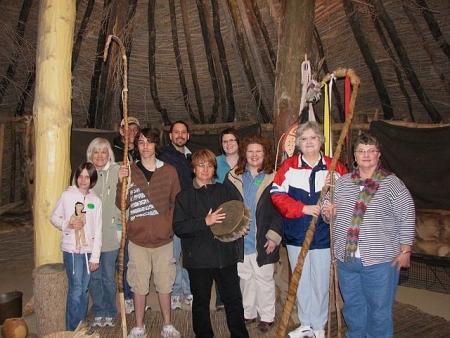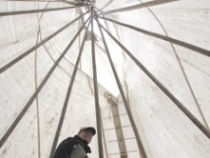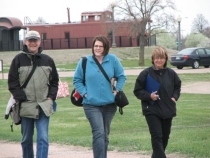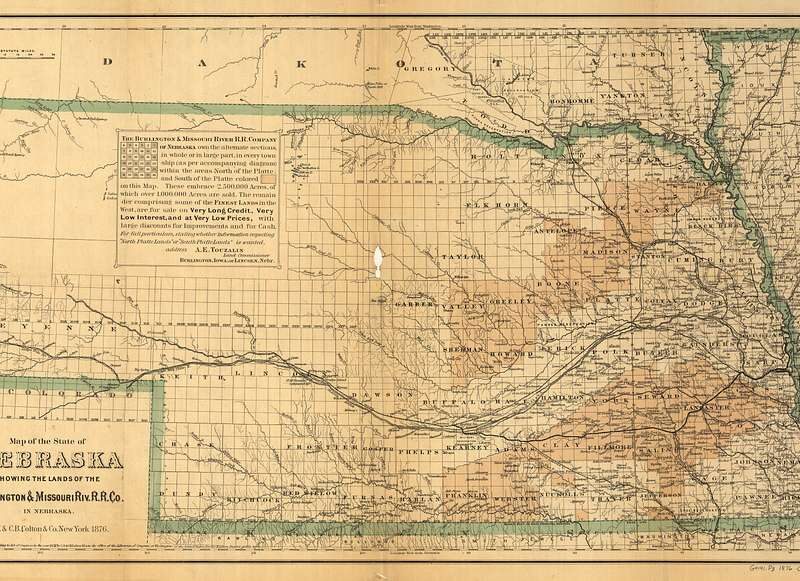.Pictured L to R: Maija Grinvalds, Lucie Carruthers, Robert Brooke, Kyle Grinvalds, Jeff Grindvalds, Gloria Waters, Katrina Cooksley-Gotschall, Susan Martens-Baker, Sharon Bishop, Marcia Misegadis. Photo credit: Jeff Grinvalds
Eleven Nebraska Writing Project teachers and family members braved a cold Nebraska Saturday for the Spring Writing Marathon on April 25th. Teachers came from all across the state to wander and write their way through the Stuhr Museum of the Prairie Pioneer in Grand Island, Nebraska (http://www.stuhrmuseum.org/).
Maija Grinvalds of Ashland Elementary School, daughter of Jeff Grinvalds, composed a poem during her day at the Stuhr:
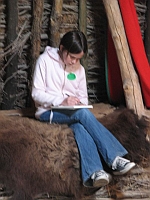
The Wooden Horse
by Maija Grinvalds
The wooden horse strong as most horses are,
big as most horses are,
is still standing when all horses cannot;
a proud, hard working species.
He is still standing after all other horses have crumbled,
metal horse rusted away,
clay horse crushed and trampled,
glass horse shattered and cracked.
Wooden horse is able to keep the other horses’ spirits alive.
Wooden horse roams free looking for others of his kind.
After an orientation by marathon organizer Sharon Bishop and a welcome from Stuhr Museum staff, writers viewed artifacts from prairie pioneer life and warmed up in a Pawnee earth lodge. Inspired by these writing stops, Marcia Misegadis of North Platte wrote the following:
The Role of Early Women on the Prairie
As I gaze through the glassed in area, inside the rotunda at the Stuhr Museum, I notice the colorful, beaded moccasins, and dresses of soft, worked leather, with fringe hanging downward. I ponder the work, the training, the will that it took to fashion these pieces of clothing. Who are these creative women who formed these beautiful clothes? What was life like for them? How hard was it to survive and “grow” your family on the open prairie, throughout the seasons? I compare my cozy, brick home, on a street named Sunset, that withstands season after season on a cantankerous prairie, and I realize my life is far different from these early women. (Or is it?) I now wonder which of these women might have lived on the same grounds as my house.
One thing that I learned at the Pawnee earthen lodge, to the west of the rotunda, was that the woman owned the lodge and had control of who lived inside its walls. That information made my heart happy. They had a grand home to call their own, a large family to fill it and a say in the way their culture shaped itself. I imagine thriving communities inside the walls of the lodges, each member working hard to live a fulfilling, happy life. Now I feel lighthearted.
Another area of interest for me was the plants and herbs that were beside the bead work. I have wondered about medicines, cures, salves and where they came from. How were these miracle plants discerned from other vegetation on the prairie? Somehow these early citizens acquired insight into the medicinal uses of prairie plants. That encouraged me to consider who might have needed these cures and how they were used and improved. My mind conjures up old western movies and how often early plains people were referred to as ignorant and savage. Upon visiting the Stuhr Museum, I better understand how advanced they were in the care and raising of their families. Early families survived and thrived on the relentless prairie. Much of this excellent living was due to the women who cared for them.
A display of “hair wreaths” in the Stuhr’s beautiful main building caught Susan Martens-Baker’s eye:
The plaque reads, “During the 19th century, human hair was often formed into wreaths, knots, or bouquets. Young women often made bouquets containing the hair of all the family members. Commonly, memorial wreaths were made from the hair of a dead relative. With the advent of home photography, this practice began to die out. ”
Brown and grey hair, worked with black thread, loops into flowers, leaves and tendrils beneath a glass frame. Beside different clusters are names: Edwin and Harriet Griffin, Matilda and Charles Stutzman, Sylvester Griffin Jr. It’s stunning workmanship, but more than that, the weight of the task! Sitting for hours, twisting the hair of dead relatives into flowers, what must they have felt? Sharon sees me studying the display and demonstrates the typical reaction from her students. “Oh, Gu-ross!” she says, mining teenage intonation. I stand somewhere between disgust and awe. How this work must have helped so many, before there were grief counselors. How many must it have driven further into despair, fixating on the loss with each pass of the needle? What courage in these women, feeling the very fiber of their families, drawing it through their hands.

Writing marathon participants also wandered through the living history village of Railroad Town, visiting with colorful townspeople from 1895. Robert Brooke chatted with the local blacksmith and took a turn as an apprentice:
The #1 health problem for blacksmiths, says Randy Dack, was loss of hearing. After 30 years of banging metal on metal, a guy would go mostly deaf. I noticed the potential for this right away when Mr. Dack showed me how to train as an apprentice: together on the anvil, he with a small finishing hammer and me (the apprentice) with the heavier sledge. He’d tap the metal where he wanted me to strike it– I would — and when he wanted me to stop he’d tap the back of the anvil. That series of taps, the front working ones higher in tone, the back anvil ones low and resonant, were all the communication they’d need. And a good thing too, because each tap made my own hearing aids *pop* clearly overloading the circuits.
The writing marathon concluded with a traditional read-around in the Town Hall, where Katrina Gotschall of O’Neill read this poem:
Sitting here,
A wasichu,
studying the portraits
of the original Department of Homeland Security,
I find myself finally swept with familiar feelings.
Feelings I anticipated; feelings that did not manifest
until this moment, in this room.
The odor of saddle soap and old leather
pierces the nostrils as
the exterior door of the rotunda opens
to this niche that encapsulates time.
I soak in the mustiness of Plains history
and peruse the exhibit that depicts how natives
evolved with the socialization of
the white man.
In front, the museum case
displays chert, knapped
into weaponry and functional tools,
illustrations of the importance
of the horse and dog,
and rifles and whisky. . .a native’s legacy?
I shake my head at the thought, and my mind
departs for just a moment to a documentary
on Whiteclay shown to my students.
A quiver of anger rises;
“Not today Katrina”.
To my right, the McClellan saddle
and a giant wooden horse draw a grin
from my wind-chilled face.
“Good ol’ Gin. “
My first steed,
a decrepit, but valiant, Palomino gelding
with a bad case of heaves.
I loved him, and cried
when I had to let him go.
One of my first lessons in death.
The side saddle harkens
thoughts of my grandmother;
88 years young, with the feistiness
of her mother, Hetty.
Cowboy boots
and waist length hair braided around her head.
Trademarks.
A proud countenance bears eyes laden
with wisdom, opinions, and anecdotes. . . “MaryBellisms”
I should spend more time writing them down;
they are worth remembering.
Just now, emotion wells from within.
How much more time do I have with her?
The exhibit suddenly fades
and I begin to bathe in
the musty smell of peppermint candy
from the carpet bag
that used to hang on the rocking chair in the
living room of the homestead.
I sit here, smiling.

